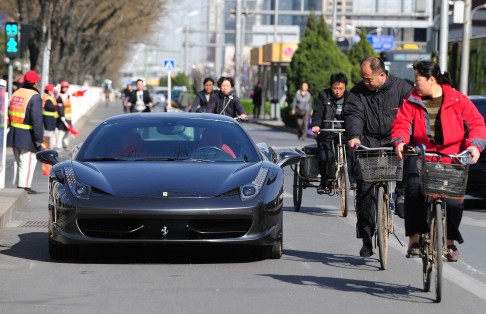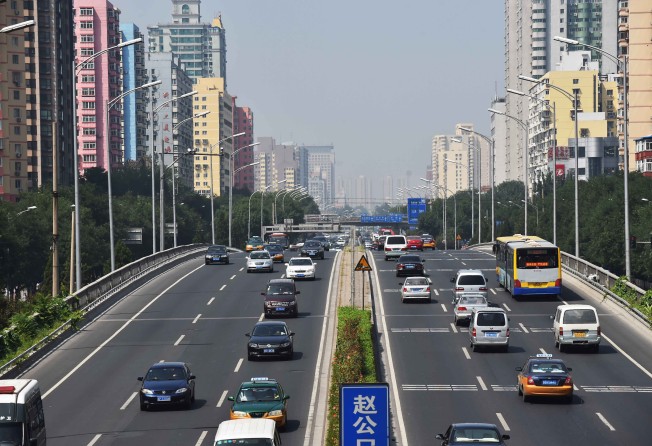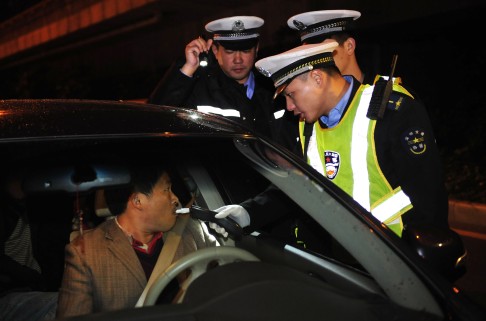
Do some Chinese drivers prefer to kill than just injure pedestrians? US lawyer explains a twisted road logic

It seemed too shocking and warped to be true: that there exists an "unspoken rule" among Chinese drivers that it is better to leave a pedestrian dead than alive if they are accidentally run over by one's vehicle.
But Geoffrey Sant, an adjunct professor of law at Fordham University and special counsel at the Dorsey & Whitney law firm in New York, argued just that. Writing in Slate, he said that mainland China's "perverse" victims compensation law meant the cost of recompensing an injured but alive victim outweighed that of indemnifying the family of one who died.
Sant first heard about the concept of "hit to kill" when he was living in Taiwan from 1996 and 2000. He also lived in other parts of Asia until 2003.
However, some readers commenting on the story questioned the veracity of the claim, saying there was a lack of statistics and that it painted an incomplete picture of Chinese drivers. Taiwan and the mainland have different regulations on traffic and compensation, with Taiwan having traffic courts that can handle criminal cases involving drivers.
Still, his article titled "Driven to kill" has been shared 99,100 times on Facebook, drawn more than 1,200 comments (mostly shock and disbelief) and even inspired Slate to host an online question-and-answer session with Sant.
Here, Sant - who still spends "extended periods of time" in China, including Hong Kong - answers queries from the South China Morning Post on justice, driving in China and scepticism over the "hit to kill" phenomenon.
What compelled you to write about the “hit-to-kill” phenomenon recently and the gaps in victims compensation law?
I was aware of the hit-to-kill phenomenon as early as the mid-1990s, when (as I mention in my article) a friend told me about it. However, I hadn’t really thought about writing it until around 2012. In 2012, I wrote an article on a different issue – the problem of substitute criminals, where a person will hire or arrange someone else to take his place in prison or court.
After that article, one of my PRC [mainland Chinese] friends asked me if I planned to write next about the double-hit phenomenon. At the time, however, I felt that Western audiences wouldn’t believe the story unless I found a lot of actual videos showing it happen. This summer, I finally had some free time, and searched out videos that showed hit-to-kill cases, such as security cameras that caught drivers repeatedly driving back and forth over a pedestrian. Once I found a number of videos, I felt comfortable writing the story.
You also say in the article that hit-to-kill cases are “fairly common” – do you mind expounding on how you arrived at this conclusion?
I think the “fairly common” comment has been misunderstood by some readers. I want to clarify that by “fairly common,” I am referring to the fact that these cases occur regularly and repeatedly across the course of a year. I am not claiming that a high percentage of traffic accidents result in hit-to-kill.
How common is hit-to-kill? On July 5, 2013, People’s Daily [the Chinese Communist Party’s newspaper] republished an editorial on hit-to-kill that had originally appeared in Worker’s Daily. In this editorial, People’s Daily quoted a truck driver as saying, [translated] “Actually, the idea that it is better to hit to kill than hit and injure has already become an unspoken rule in our profession.
"Each of us is actually able to pay out the compensation required for hitting and killing a person, but I’m afraid that not everyone can pay the compensation for hitting and injuring a person.”
The People’s Daily editorial acknowledged that the compensation payment for crippling or putting a person into a vegetative state could be “bottomless”.
(Warning: Disturbing scenes) In 2011 case that shocked the world, Chinese toddler struck by two trucks - and no one stops to help
The truck driver spoke of an “unspoken rule” but how often do drivers act on this rule? I am able to find plenty of media and social media reports about hit-to-kill. Roughly speaking, about once a month a new alleged instance of hit-to-kill surfaces in news reports or on social media.
Of course, the drivers who hit-to-kill do so because they think they will not be caught. What percentage of these cases are actually discovered (either due to an eyewitness or because the event was caught on video)? And, on the other hand, how many hit-to-kills are “successful” and go undiscovered? This question is by its nature impossible to answer with certainty (how can anyone know how many cases go undiscovered or unreported?).
Nevertheless, if one assumes that at least half or more of these cases go undiscovered, then the phenomenon must be occurring at least every couple of weeks. I suspect it occurs even more often than that. This is what I mean by “fairly common”. I am referring to these cases happening repeatedly across the course of the year. I am not claiming that a high percentage of traffic accidents end in hit-to-kill.
Are there any available statistics?
China does not keep statistics on hit-to-kill incidents (or allegations), but statistics on traffic accidents are quite interesting. Xinhua News Agency has reported that in the PRC, there is a four-to-one ratio of traffic accidents resulting in injury versus traffic accidents resulting in death. In the United States, the ratio is approximately 70 to 1.
This means that traffic accidents are vastly more likely to result in death in China than in the United States. To be clear, I think that the primary reasons for this disparity include: less seatbelt use in the PRC; more drunk driving in the PRC; more dangerous driving in the PRC.
Hit-to-kill driving is far less significant, in my opinion, than these other factors. Nevertheless, the fact that such a high percentage of traffic accidents result in death is extremely disconcerting.
You mentioned attempts by Taiwan and the mainland to eradicate hit-to-kill cases. Are they enough? What can be improved?
Taiwan seems to have done a good job of cleaning up the hit-to-kill phenomenon. Beginning in the early 2000s, Taiwan took a number of legal steps to try to eliminate hit-to-kill drivers. Up until that time, hit-to-kill drivers were an open secret. Taiwan’s Lianhe Bao (Taiwan’s largest newspaper at the time), wrote in 2002: “A long-enduring, strange social phenomenon in Taiwan has finally attracted the attention of the legislature … professional drivers have developed the perverse idea that ‘it is better to hit to kill than to hit and injure.’” [translation]
My impression is that Taiwan’s traffic situation has improved drastically over the past decade. It is difficult for me to sort out which legal and social changes were most responsible for the improvements in Taiwan. It may be that, as you suggest, the traffic courts have been effective in eliminating the problem in Taiwan.
It could also be a result of legal changes, such as improving the ability to bring civil suits on behalf of the deceased, or it could result from social improvements, or better policing. I’m afraid I don’t know which of these factors have been most important. Taiwan’s traffic still has a ways to go, but it is much better than before.
(Warning: Disturbing scenes) Chinese grandmother killed in 2014 after being struck by a series of cars
In the case of the PRC, the central government has focused its efforts to eliminate hit-to-kill by emphasising that hit-to-kill is murder, and must be treated as such; and attempting to persuade the public that hit-to-kill is both wrong and foolish.
In the July 5, 2013 editorial mentioned above, for example, the People’s Daily provided a series of reasons why hit-to-kill didn’t make sense, including the argument that the driver should expect to be caught and that the driver would be punished vastly more severely for a murder than for accidentally injuring a person.
This sort of social persuasion has its value, but I think there are two much more important steps that need to be taken. First, I think China needs to change its compensation system so that traffic accidents resulting in death result in much higher compensation, closer to the upper bound of compensation for crippling a victim. If this was the case, there would be no financial incentive to hit-to-kill.
Second, China’s anti-corruption campaign should focus more particularly on eliminating bribery and corruption in the judicial system.
Do you think a better insurance system would have a knock-on effect on rebalancing compensation policies?
It may also be true, as you suggest, that changes to China’s insurance scheme could be helpful. I’m not an expert on PRC insurance, unfortunately, so I’m afraid I can’t be very helpful on that question.
Tell us about the responses you’ve received about your Slate article.
In the US, there has been a mixed reaction to the Slate article. There has been a lot of shock, but also some folks who claim I must be lying about these incidents. I find the accusations of lying to be strange considering that People’s Daily and other major Chinese media have acknowledged these incidents occur, and in fact people have been convicted of these crimes, and there are videos showing the crime happening.
In response to my article, I received a number of messages claiming that places like Vietnam and Mexico also have this problem, but I have no way of knowing whether or not these claims are true.
Do you know of any campaign groups in China that are lobbying to remedy this problem?
There are some campaigns to improve pedestrian safety in China, but these campaigns are not connected specifically to hit-to-kill. One well-known example is the efforts of the city of Hangzhou in response to a tragic traffic accident where a drag racer killed a pedestrian who was in the middle of walking across a crosswalk in 2009.
The city of Hangzhou made an effort to force public buses and others to stop at crosswalks and red lights, and some crosswalks were even painted with hearts to emphasise traffic safety.
Would you ever drive in China?
When I lived in Taoyuan county, Taiwan in the 1990s, I drove a scooter. The most dangerous thing I did in Taoyuan county, Taiwan was to try to obey the traffic laws! (Right-of-way went to the biggest vehicle, followed by the next largest vehicle, and so on.) I think Taiwan’s traffic has improved immensely since the 1990s, although it can still improve further. I’ve never driven in the PRC.
Responses and questions have been edited for style.

